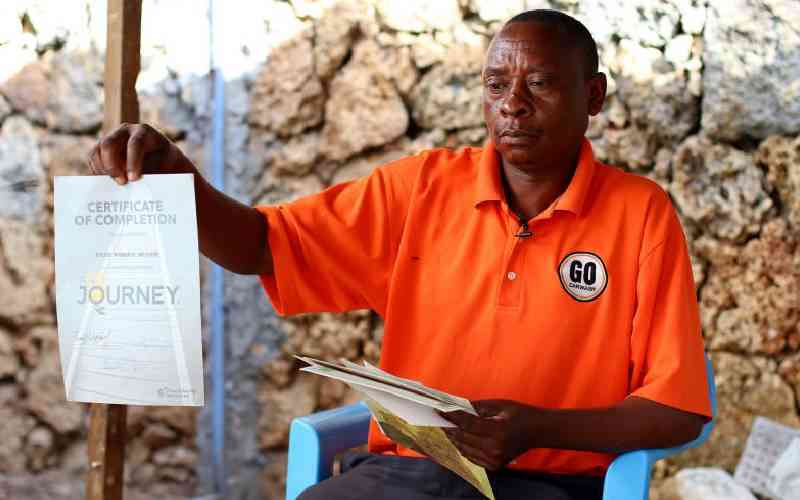Kiundu Waweru
Nestled between Tom Mboya Street and Moi Avenue is the historic Kenya National Archives Building. The newly painted building stands next to the Ambassador Hotel and opposite the Hilton Hotel in an area that is perhaps the busiest in Nairobi. Taxis, matatus and buses honk and blare as they break all the traffic rules. The foot traffic is huge around Kencom and Ambassador bus stops. Most mortals and newcomers to Nairobi meet and wait for their dates at Kencom. Others, mostly hospitality industry jobseekers, while away the desperate hours at "the round table" in front of the Hilton.
Surprisingly, looking towards the entrance of the imposing building, amongst the sea of activity and humanity, you will see few going inside to sample the documented rich history of "a working nation" save for some students and occasional people doing a particular research, and of course, tourists.
And just inside the building, on the ground floor, you come to a standstill as the chaos of the streets, now a distant whisper, is transformed to serenity by a beautiful collection of artwork in display at The Murumbi Gallery.
Joseph Murumbi’s collection, the first foreign Minister of Independent Kenya, according to Azangu Eliakim, Head of Research, National Archives is in three parts: Books/ publications, records and material culture.
Art history
Murumbi collected over 2,000 rare books that cover African history, expeditions and travels. The records involve the ones he collected in his official capacity in the Government, and also private and personal letters and cards. The records are kept in the private archives, and the books are displayed in the Murumbi Africana Book library alongside the National Archives Library.
The material culture includes a wide range of original items collected from West, Central and East Africa. They are items covering every aspect of human life, artwork (paintings, drawings, carvings and pottery and clothing). The collection also comprises of mythology, magic, weaponry and farm inputs.
Murumbi, in his quest for rehabilitating the African culture, left no stone unturned. The raw materials of the collection are diverse as the content. There are items made from wood, stone, clay, ivory, hide skins, bronze/brass and even bones.
As you go in, you are confronted by large, heavy wooden chests emblazoned with bronze. The chests were collected from the Swahili people. They were owned by the rich for placing valuables like jewellery. Also, there is a Swahili bed and crib and chair all made from hardwood and beautifully adorned.
The diverse and rich Kenyan culture is captured in this room. From the world famous Maasai adornment to Swahili khanga and a picture of a woman applying henna to Turkana metal jewellery and Kamba magic — there is a Kamba hand-woven basket, kiondo, complete with the medicine man’s or witchdoctor, charms and ‘medical’ paraphernalia.
Mumbi Myth
Standing out is a sculpture depicting the myth of the origins of the Kikuyu tribe. At the base of the sculpture can be seen a head of a primordial woman, Mumbi, in the throes of childbirth. At the top are nine breasts representing the nine females. The sculpture is credited to Francis Muthuri Amundi who made it in 1971. Also by Amundi is a sculpture of Mumbi as a young foetus symbolically protected from evil within the mighty hand of ‘mugwe’ considered to be the original god of the Kikuyu people.
One needs to visit the gallery to experience the colourful diverse culture; get treated to Turkana ostrich egg shell beads to paintings of famous Nigerian, Muraini Oyelami to Makonde and Ebony Sculptures of Tanzania and Mozambique noted for abstract sculptures with fanciful themes as well as ‘tree of life’ some of which derive from the Ujamaa period of Tanzania, a vigorous comment on the human story of life in a tribal setting.
The Murumbi collection succeeds in archiving history. For instance, majority of the living Kenyans know about the colonialists and their oppressive rule from their mediocre history books and from stories from the older generation. In 1922, the colonialists devised an "identification" made of metal which was to be worn at all times like a necklace. It came to be popularly known as kipande.
Stay informed. Subscribe to our newsletter
It is to be found here at The Murumbi Gallery with all the painful memories it conjures about the fore parents’ suffering.
 The Standard Group Plc is a
multi-media organization with investments in media platforms spanning newspaper
print operations, television, radio broadcasting, digital and online services. The
Standard Group is recognized as a leading multi-media house in Kenya with a key
influence in matters of national and international interest.
The Standard Group Plc is a
multi-media organization with investments in media platforms spanning newspaper
print operations, television, radio broadcasting, digital and online services. The
Standard Group is recognized as a leading multi-media house in Kenya with a key
influence in matters of national and international interest.
 The Standard Group Plc is a
multi-media organization with investments in media platforms spanning newspaper
print operations, television, radio broadcasting, digital and online services. The
Standard Group is recognized as a leading multi-media house in Kenya with a key
influence in matters of national and international interest.
The Standard Group Plc is a
multi-media organization with investments in media platforms spanning newspaper
print operations, television, radio broadcasting, digital and online services. The
Standard Group is recognized as a leading multi-media house in Kenya with a key
influence in matters of national and international interest.







